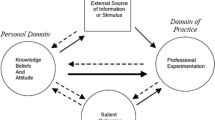Abstract
This article presents research on how teacher developers in the United States learn to conduct lesson study. Although the practice of lesson study is expanding rapidly in the US, high-quality implementation requires skilled facilitation. In contexts such as the United States where this form of professional development is relatively novel, few teachers have participated in lesson study, so leaders of lesson study groups do not have that prior experience to draw upon for facilitation. To establish lesson study groups, teacher developers are therefore needed in the US context, but we know little about how leaders who are new to lesson study learn to do this work. To investigate this, two novice teacher developers were followed for a period of eighteen months, from their first exposure to the literature on lesson study, through their participation in lesson study conferences, apprenticeship with an experienced lesson study leader, and into their independent conduct of lesson study groups. Data show that the facilitators learned to contend with such issues as teacher resistance, the use of time, and the shifting imperatives of directing teachers’ work versus stepping back to give teachers autonomy in determining their collective work. The article concludes by suggesting that lesson study functions as a countercultural bulwark in the field of teacher learning by promoting a participant-driven, time-intensive form of professional development, and that, despite its novelty and complexity, teacher developers with strong mathematical and pedagogical backgrounds become reasonably skillful facilitators in a surprisingly short span of time.


Similar content being viewed by others
Notes
All names in this article are pseudonyms.
Some lesson study advocates recommend that participants volunteer to take part to ensure buy-in; in Asian countries it is common that an entire faculty or department participates in a lesson study group.
References
Bolster, A. S. (1983). Toward a more effective model of research on teaching. Harvard Educational Review, 53(3), 294–308.
Bourdieu, P. (1990). The logic of practice (R. Nice, Trans.). Stanford: Stanford University Press.
Clift, R. T., & Brady, P. (2005). Research on methods courses and field experiences. In M. Cochran-Smith & K. Zeichner (Eds.), Studying teacher education (pp. 309–424). Mahwah: Lawrence Erlbaum Associates Inc.
Corbin, J., & Strauss, A. (2008). Basics of qualitative research: Techniques and procedures for developing grounded theory. Thousand Oaks: Sage.
Edwards, C. (1993). The hundred languages of children: The Reggio Emilia approach to early childhood education. Norwood: Ablex Publishing Corporation.
Feiman-Nemser, S. (1983). Learning to teach. In L. Shulman & G. Sykes (Eds.), Handbook of teaching and policy (pp. 150–170). New York: Longman.
Gersten, R., Taylor, M. J., Keys, T. D., Rolfhus, E., Newman-Gonchar, R. (2014). Summary of research on the effectiveness of math professional development approaches. Washington, DC: US Department of Education, Institute of Education Sciences, National Center for Educational Evaluation and Regional Assistance, Regional Educational Laboratory Southeast.
Grossman, P., Compton, C., Shahan, E., Ronfeldt, M., Igra, D., & Shaing, J. (2007). Preparing practitioners to respond to resistance: a cross-professional view. Teachers and Teaching: Theory and Practice, 13(2), 109–123.
Grossman, P., Wineburg, S., & Woolworth, S. (2001). Toward a theory of teacher community. The Teachers College Record, 103(6), 942–1012.
Hord, S. M., & Sommers, W. A. (Eds.). (2008). Leading professional learning communities: voices from research and practice. Newbury Park: Corwin Press.
Isoda, M., Stephens, M., Ohara, Y., & Miyakawa, T. (Eds.). (2007). Japanese lesson study in mathematics: Its impact, diversity and potential for educational improvement. Singapore: World Scientific Publishing.
Lampert, M., & Clark, C. M. (1990). Expert knowledge and expert thinking in teaching: A response to Floden and Klinzig. Educational Researcher, 19(5), 21.
Lewis, C. C., Perry, R. R., & Hurd, J. (2009). Improving mathematics instruction through lesson study: A theoretical model and North American case. Journal of Mathematics Teacher Education, 12(4), 285–304.
Lewis, C., Perry, R., & Murata, A. (2006). How should research contribute to instructional improvement? The case of lesson study. Educational Researcher, 35(3), 3–14.
Lewis, C. & Tsuchida, I. (1997). A lesson is like a swiftly flowing river: How research lessons improve Japanese education. American Educator, Winter, pp. 12–17, 50–52.
Lewis, J. M., Fischman, D., Riggs, I., & Wasserman, K. (2013). Teachers learning in lesson study. The Mathematics Enthusiast, 10(3), 583–619.
Lortie, D. C. (1975). Schoolteacher: a sociological study. Chicago: University of Chicago Press.
Miller, J. B., & Stiver, I. (2015). The healing connection: How women form relationships in therapy and in life. Boston: Beacon Press.
National Governors Association Center for Best Practices & Council of Chief State School Officers. (2010). Common core state standards: Standards for mathematical process. Author: Washington D.C.
Organisation for Economic Co-operation and Development (2014). Education at a glance 2014. OECD Indicators, OECD Publishing. doi:10.1787/eag-2014-en.
Pickering, A. (1995). The mangle of practice. Chicago: University of Chicago.
Puchner, L. D., & Taylor, A. R. (2006). Lesson study, collaboration and teacher efficacy: Stories from two school-based math lesson study groups. Teaching and Teacher Education, 22(7), 922–934.
Raider-Roth, M., Stieha, V., & Hensley, B. (2012). Rupture and repair: Episodes of resistance and resilience in teachers’ learning. Teaching and Teacher Education, 28(4), 493–502.
Stigler, J. W., & Hiebert, J. (1999). The teaching gap: Best ideas from the world’s teachers for improving education in the classroom. New York: The Free Press.
Yin, R. K. (2009). Case study research: Design and methods. Thousand Oaks: Sage.
Author information
Authors and Affiliations
Corresponding author
Rights and permissions
About this article
Cite this article
Lewis, J.M. Learning to lead, leading to learn: How facilitators learn to lead lesson study. ZDM Mathematics Education 48, 527–540 (2016). https://doi.org/10.1007/s11858-015-0753-9
Accepted:
Published:
Issue Date:
DOI: https://doi.org/10.1007/s11858-015-0753-9




